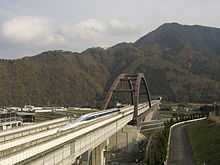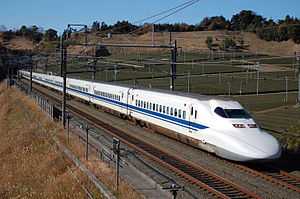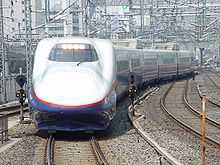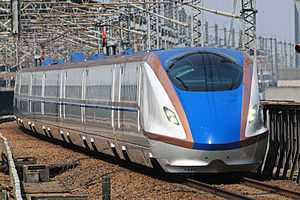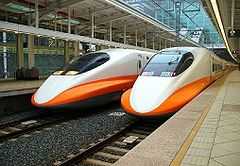Shinkansen


The Shinkansen (新幹線, new trunk line) is a network of high-speed railway lines in Japan operated by four Japan Railways Group companies. Starting with the Tōkaidō Shinkansen (515.4 km, 320.3 mi) in 1964,[1] the network has expanded to currently consist of 2,615.7 km (1,625.3 mi) of lines with maximum speeds of 240–320 km/h (150–200 mph), 283.5 km (176.2 mi) of Mini-shinkansen lines with a maximum speed of 130 km/h (80 mph), and 10.3 km (6.4 mi) of spur lines with Shinkansen services.[2] The network presently links most major cities on the islands of Honshu and Kyushu, with construction of a link to the northern island of Hokkaido underway.
The maximum operating speed is 320 km/h (200 mph) (on a 387.5 km section of the Tōhoku Shinkansen).[3] Test runs have reached 443 km/h (275 mph) for conventional rail in 1996, and up to a world record 603 km/h (375 mph) for maglev trains in April 2015.[4]
Shinkansen literally means new trunk line, referring to the high-speed rail line network. The name Superexpress (超特急 chō-tokkyū), initially used for Hikari trains, was retired in 1972 but is still used in English-language announcements and signage.
The Tōkaidō Shinkansen is the world's busiest high-speed rail line. Carrying 151 million passengers per year (March 2008),[5] it has transported more passengers (over 5 billion, entire network over 10 billion)[6] than any other high-speed line in the world. Between Tokyo and Osaka, the two largest metropolises in Japan, up to thirteen trains per hour with sixteen cars each (1,323-seat capacity) run in each direction with a minimum headway of three minutes between trains. Though largely a long-distance transport system, the Shinkansen also serves commuters who travel to work in metropolitan areas from outlying cities. Japan's Shinkansen network had the highest annual passenger ridership (a maximum of 353 million in 2007) of any high-speed rail network until 2011, when China's high-speed rail network surpassed it at 370 million passengers annually.[7]
History
Japan was the first country to build dedicated railway lines for high-speed travel. Because of the mountainous terrain, the existing network consisted of 1,067 mm (3 ft 6 in) narrow-gauge lines, which generally took indirect routes and could not be adapted to higher speeds. Consequently, Japan had a greater need for new high-speed lines than countries where the existing standard gauge or broad gauge rail system had more upgrade potential.
Among the key people credited with the construction of the first Shinkansen are Hideo Shima, the Chief Engineer, and Shinji Sogō, the first President of Japanese National Railways (JNR) who managed to persuade politicians to back the plan. Other significant people responsible for its technical development were Tadanao Miki, Tadashi Matsudaira, and Hajime Kawanabe based at the Railway Technology Research Institute (RTRI), part of JNR. They were responsible for much of the technical development of the first line, the Tōkaidō Shinkansen. All three had worked on aircraft design during World War II.[8]
Early proposals
The popular English name bullet train is a literal translation of the Japanese term dangan ressha (弾丸列車), a nickname given to the project while it was initially being discussed in the 1930s. The name stuck because of the original 0 Series Shinkansen's resemblance to a bullet and its high speed.
The Shinkansen name was first formally used in 1940 for a proposed standard gauge passenger and freight line between Tokyo and Shimonoseki that would have used steam and electric locomotives with a top speed of 200 km/h (120 mph). Over the next three years, the Ministry of Railways drew up more ambitious plans to extend the line to Beijing (through a tunnel to Korea) and even Singapore, and build connections to the Trans-Siberian Railway and other trunk lines in Asia. These plans were abandoned in 1943 as Japan's position in World War II worsened. However, some construction did commence on the line; several tunnels on the present-day Shinkansen date to the war-era project.
Construction
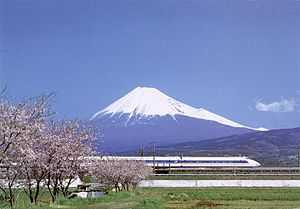
Following the end of World War II, high-speed rail was forgotten for several years while traffic of passengers and freight steadily increased on the conventional Tōkaidō Main Line along with the reconstruction of Japanese industry and economy. By the mid-1950s the Tōkaidō Line was operating at full capacity, and the Ministry of Railways decided to revisit the Shinkansen project. In 1957, Odakyu Electric Railway introduced its 3000 series SE "Romancecar" train, setting a world speed record of 145 km/h (90 mph) for a narrow gauge train. This train gave designers the confidence that they could safely build an even faster standard gauge train. Thus the first Shinkansen, the 0 series, was built on the success of the Romancecar.
In the 1950s, it was widely believed that railways would soon be outdated and replaced by air travel and highways as in America and many countries in Europe. However, Shinji Sogō, President of Japanese National Railways, insisted strongly on the possibility of high-speed rail, and the Shinkansen project was implemented.
Government approval came in December 1958, and construction of the first segment of the Tōkaidō Shinkansen between Tokyo and Osaka started in April 1959. The cost of constructing the Shinkansen was at first estimated at nearly 200 billion yen, which was raised in the form of a government loan, railway bonds and a low-interest loan of US$80 million from the World Bank. Initial cost estimates, however, had been deliberately understated and the actual figures were nearly double at about 400 billion yen. As the budget shortfall became clear in 1963, Sogo resigned to take responsibility.[9]
A test facility for rolling stock, now part of the line, opened in Odawara in 1962.
Initial success
The Tōkaidō Shinkansen began service on 1 October 1964, in time for the first Tokyo Olympics.[10] The conventional Limited Express service took six hours and 40 minutes from Tokyo to Osaka, but the Shinkansen made the trip in just four hours, shortened to three hours and ten minutes by 1965. It enabled day trips between Tokyo and Osaka, the two largest metropolises in Japan, changed the style of business and life of the Japanese people significantly, and increased new traffic demand. The service was an immediate success, reaching the 100 million passenger mark in less than three years on 13 July 1967, and one billion passengers in 1976. Sixteen-car trains were introduced for Expo '70 in Osaka. With an average of 23,000 passengers per hour in each direction in 1992, the Tōkaidō Shinkansen is the world's busiest high-speed rail line.[11]
The first Shinkansen trains, the 0 series, ran at speeds of up to 210 km/h (130 mph), later increased to 220 km/h (137 mph). The last of these trains, with their classic bullet-nosed appearance, were retired on 30 November 2008. A driving car from one of the 0 series trains was donated by JR West to the National Railway Museum in York, England in 2001.[12]
Network expansion

The Tōkaidō Line's rapid success prompted an extension westward to Hiroshima and Fukuoka (the Sanyō Shinkansen), which was completed in 1975.
Prime Minister Kakuei Tanaka was an ardent supporter of the Shinkansen, and his government proposed an extensive network paralleling most existing trunk lines. Two new lines, the Tōhoku Shinkansen and Jōetsu Shinkansen, were built following this plan. Many other planned lines were delayed or scrapped entirely as JNR slid into debt throughout the late 1970s, largely because of the high cost of building the Shinkansen network. By the early 1980s, the company was practically insolvent, leading to its privatization in 1987.
Development of the Shinkansen by the privatised regional JR companies has continued, with new train models developed, each generally with its own distinctive appearance (such as the 500 series introduced by JR West). Since 2014, shinkansen trains run regularly at speeds up to 320 km/h (200 mph), placing them alongside the French TGV and German ICE as the fastest trains in the world.
Since 1970, development has also been underway for the Chūō Shinkansen, a planned maglev line from Tokyo to Osaka. On 21 April 2015, a seven-car L0 series maglev trainset set a world speed record of 603 km/h (375 mph).[4]
Technology
To enable high-speed operation, Shinkansen uses a range of advanced technology compared with conventional rail, and it achieved not only high speed but also a high standard of safety and comfort. Its success has influenced other railways in the world and the importance and advantage of high-speed rail has consequently been reevaluated.
Routing
Shinkansen routes are completely separate from conventional rail lines (except Mini-shinkansen which goes through to conventional lines). Consequently, Shinkansen is not affected by slower local or freight trains and has the capacity to operate many high-speed trains punctually. The lines have been built without road crossings at grade. Tracks are strictly off-limits with penalties against trespassing strictly regulated by law. It uses tunnels and viaducts to go through and over obstacles rather than around them, with a minimum curve radius of 4,000 meters (2,500 meters on the oldest Tōkaidō Shinkansen).[13]
Track
The Shinkansen uses 1,435 mm (4 ft 8 1⁄2 in) standard gauge in contrast to the 1,067 mm (3 ft 6 in) narrow gauge of older lines. Continuous welded rail and Swingnose crossing points are employed, eliminating gaps at turnouts and crossings. Long rails are used, joined by expansion joints to minimize gauge fluctuation due to thermal elongation and shrinkage.
A combination of ballasted and slab track are used, with slab track exclusively employed on concrete bed sections such as viaducts and tunnels. Slab track is significantly more cost-effective in tunnel sections, since the lower track height reduces the cross-sectional area of the tunnel, thereby reducing construction costs by up to 30%.[14] However, the smaller diameter of Shinkansen tunnels compared to some other high-speed lines has resulted in the issue of tunnel boom becoming a concern for residents living close to tunnel portals.
Signal system
The Shinkansen employs an ATC (Automatic Train Control) system, eliminating the need for trackside signals. It uses a comprehensive system of Automatic Train Protection.[9] Centralized traffic control manages all train operations, and all tasks relating to train movement, track, station and schedule are networked and computerized.
Electricity
Shinkansen uses a 25,000 V AC overhead power supply (20,000 V AC on Mini-shinkansen lines), to overcome the limitations of the 1,500 V direct current used on the existing electrified narrow-gauge system. Power is distributed along the axles of the train to reduce the heavy axle loads under single power cars.[9]
Trains
Shinkansen trains are electric multiple unit style, offering high acceleration and deceleration, and reduced damage to the track because of lighter vehicles. The coaches are air-sealed to ensure stable air pressure when entering tunnels at high speed.
Punctuality
The Shinkansen is very reliable thanks to several factors, including its near-total separation from slower traffic. In 2012, JR Central reported that the Shinkansen's average delay from schedule per train was 36 seconds. This includes delays due to uncontrollable causes, such as natural disasters.[15] The record, in 1997, was 18 seconds.
Traction
The Shinkansen has used the electric multiple unit configuration from the outset, with the 0 Series Shinkansen having all axles powered. Other railway manufacturers have traditionally been reluctant, or unable to use distributed traction configurations (e.g. Talgo utilised the locomotive configuration with the AVE Class 102 and plans to continue with it for the Talgo AVRIL on account of the fact that it is not possible to utilise powered bogies as part of the Talgo Pendular system). In Japan significant engineering desirability exists for the electric multiple unit configuration. A greater proportion of motored axles results in higher acceleration, meaning that the Shinkansen does not lose as much time if stopping frequently. Shinkansen lines have more stops in proportion to their lengths than high-speed lines elsewhere in the world.
Safety record
Over the Shinkansen's 50-year history, carrying nearly 10 billion passengers, there have been no passenger fatalities due to derailments or collisions,[16] despite frequent earthquakes and typhoons. Injuries and a single fatality have been caused by doors closing on passengers or their belongings; attendants are employed at platforms to prevent such accidents. There have, however, been suicides by passengers jumping both from and in front of moving trains.[17]
There have been two derailments of Shinkansen trains in passenger service. The first one occurred during the Chūetsu Earthquake on 23 October 2004. Eight of ten cars of the Toki No. 325 train on the Jōetsu Shinkansen derailed near Nagaoka Station in Nagaoka, Niigata. There were no casualties among the 154 passengers.[18]
Another derailment happened on 2 March 2013 on the Akita Shinkansen when the Komachi No. 25 train derailed in blizzard conditions in Daisen, Akita. No passengers were injured.[19]
In the event of an earthquake, an earthquake detection system can bring the train to a stop very quickly. A new anti-derailment device was installed after detailed analysis of the Jōetsu derailment.
Economics
The Shinkansen has had a significant effect on Japan's business, economy, society, environment and culture.[11] The time savings alone from switching from a conventional to a high-speed network have been estimated at 400 million hours, an economic impact of ¥500 billion per year.[11] Shinkansen connectivity has rejuvenated rural towns such as Kakegawa that would otherwise be too distant from major cities.[11]
However, the vast construction costs of the Shinkansen network, particularly the later, less profitable lines often driven more by political considerations than actual demand, imposed vast debt servicing costs on JNR that, by 1971, made JNR unprofitable even before depreciation.[20] JNR's Shinkansen-fueled debt eventually ballooned to ¥28 trillion(275 billion USD/200 billion Euro) and was an instrumental factor in the company's eventual privatization and breakup.[20] The privatized JRs eventually paid a total of only ¥9.2 trillion to acquire JNR's Shinkansen network.[11]
Environmental impact
Traveling the Tokyo-Osaka line by Shinkansen produces only around 16% of the carbon dioxide of the equivalent journey by car, a saving of 15,000 tons of CO2 per year.[11]
Challenges encountered
Noise pollution
Noise pollution concerns mean that increasing speed is becoming more difficult. In Japan, the population density is high and there have been severe protests against noise pollution of Shinkansen, and now Shinkansen noise is regulated to less than 70 dB in residential areas.[21] Hence, improvement and reduction of pantograph, weight saving of cars, and construction of noise barriers and other measures have been implemented. Current research is primarily aimed at reducing operational noise, particularly the tunnel boom phenomenon caused when trains transit tunnels at high speed.
Earthquake
Because of the risk of earthquakes, the Urgent Earthquake Detection and Alarm System (UrEDAS) (earthquake warning system) was introduced in 1992. It enables automatic braking of bullet trains in the case of large earthquakes.
Heavy snow
The Tōkaidō Shinkansen often experiences heavy snow in the area around Maibara Station in winter. Trains have to reduce speed, which can disrupt the timetable. Sprinkler systems were later installed, but delays of 10 to 20 minutes still occur during snowy weather. Additionally, treefalls related to excess snow have caused service interruptions. Along the route of the Jōetsu Shinkansen, winter snow can be very heavy, with snow depths of two to three metres, so the line is equipped with stronger sprinklers and slab track, to mitigate the effects of deep snow.
Ridership
| Year | Shinkansen (incl TWHSR from 2010) | Asia (other) | Europe | World | World(%) |
|---|---|---|---|---|---|
| 1964 | 11.0 | 0 | 0 | 11.0 | 100% |
| 1980 | 1,616.3 | 0 | 0 | 1,616.3 | 100% |
| 1985 | 2,390.3 | 0 | 45.7 | 2,436.0 | 98.1% |
| 1990 | 3,559.1 | 0 | 129.9 | 3,689.0 | 96.5% |
| 1995 | 5,018.0 | 0 | 461 | 5,479 | 91.6% |
| 2000 | 6,531.7 | 0 | 1,103.5 | 7,635.1 | 85.5% |
| 2005 | 8,088.3 | 52.2 | 2,014.6 | 10,155.1 | 79.6% |
| 2010 | 9,651.0 | 965 | 3,177.0 | 15,417 | 70.8% |
| 2012 | 10,344 | 2,230 | 3,715 | 16,210 | 64.5% |
| 2014 | 11,050 | 3,910 | 4,300 | 19,260 | 57.4% |
Notes:
- Data in italics includes extrapolated estimations where data is missing. Turkey and Russia data here is included in Europe column, not split between Asia and Europe.
- "World(%)" refers to Shinkansen riders as a percent of world total.
- For 2013, Japan's Mininstry of Transport has not updated data, nor is summed European data available (even 2012 data is very rough), however Taiwan ridership is 47.49 million[24] and Korea with 54.5 million[25] and China with 672 million in 2013.[26]
| Tokaido | Tohoku | Sanyo | Joetsu | Nagano | Kyushu | Sum (not actual total) | |
|---|---|---|---|---|---|---|---|
| 2007 | 151.32[23] | 84.83[23] | 64.43[23] | 38.29[23] | 10.13[23] | 4.18[23] | 353.18 |
Annual ridership has fallen since 2007, to 307 million as of 2011, although the Kyushu line (connected to the Sanyo Shinkansen in March 2011) has seen significant gains while patronage on other lines has fallen. Until 2011, Japan's high-speed rail system had the highest annual patronage, when China's HSR network's patronage reached 440 million.[6]
Cumulative ridership since October 1964 is over 5 billion passengers for the Tokaido Shinkansen and 10 billion passengers for Japan's entire shinkansen network.[6]
Future

Speed increases
E5 series trains, capable of up to 320 km/h (200 mph) (initially limited to 300 km/h), were introduced on the Tōhoku Shinkansen in March 2011. Operation at the maximum speed of 320 km/h between Utsunomiya and Morioka on this route commenced on 16 March 2013, and reduced the journey time to around 3 hours for trains from Tokyo to Shin-Aomori (a distance of 674 km (419 mi)).
Extensive trials using the Fastech 360 test trains have shown that operation at 360 km/h (224 mph) is not currently feasible because of problems of noise pollution (particularly tunnel boom), overhead wire wear, and braking distances. On 30 October 2012, JR East announced that it is pursuing research and development to increase speeds to 360 km/h on the Tohoku Shinkansen by 2020.[27]
Hokuriku extension
The Hokuriku Shinkansen is being extended from Kanazawa to Tsuruga (proposed for completion by 2022) at an estimated cost of 3.04 trillion yen (in June 2012).[28] There are further plans to extend the line from Tsuruga to Osaka, and there are currently 3 routes under consideration.
Tohoku extension/Hokkaido Shinkansen
The Tōhoku Shinkansen is being extended by JR East from Shin-Aomori to the new Shin-Hakodate station north of the Hokkaido city of Hakodate through the Seikan Tunnel, which is being converted to dual gauge as part of the project, with scheduled completion in March 2016.
For at least the initial two years after opening, Shinkansen trains will be limited to 140 km/h when traversing the dual gauge Seikan tunnel due to the risk of narrow gauge freight trains traveling in the opposite direction being derailed by the shockwave of air that moves ahead of Shinkansen trains at higher speeds in tunnels. There are currently approximately 50 freight trains traversing the Seikan tunnel each day, and so limiting the travel of such trains through the tunnel to times outside of Shinkansen services is not an option.
In 2018, it is proposed to allow one Shinkansen service each day to travel at 260 km/h (the maximum speed proposed for the tunnel) by ensuring no freight trains are scheduled to travel through the tunnel at that time.
To achieve the full benefit of Shinkansen trains travelling through the tunnel at 260 km/h other alternatives are being considered, such as a system to automatically slow Shinkansen trains down to 200 km/h when passing narrow gauge trains, and/or loading freight trains onto special standard gauge trains (akin to a covered piggyback flatcar train) built to withstand the shockwaves of oncoming Shinkansen trains traveling at full speed, known in Japan as Train on Train. This would enable a travel time from Tokyo to Shin-Hakodate of 3 hrs 45 mins.
JR Hokkaido is extending the Hokkaido Shinkansen from Shin-Hakodate to Sapporo to open by 2030, with tunnelling work on the 5,265m Murayama tunnel, situated about 1 km north of Shin-Hakodate station, proposed to commence by March 2015, and be completed by March 2021.
Nagasaki Shinkansen
JR Kyushu is currently constructing an extension (to be known as the West Kyushu Shinkansen) line of the Kyushu Shinkansen to Nagasaki, partly to full Shinkansen standard gauge construction standards (Takeo Onsen - Nagasaki) with the existing narrow gauge section between Shin-Tosu and Takeo Onsen utilised in conjunction with Gauge Change Trains (GCT).
This proposal would involve a GCT train travelling from Hakata to Shin-Tosu (26.3 km) on the existing Kyushu Shinkansen line, then passing through a specific gauge changing (standard to narrow) section of track linking to the existing Nagasaki Main Line, along which it would travel to Hizen Yamaguchi (37.6 km), then onto the Sasebo Line to Takeo Onsen (13.7 km), where another gauge changing section (narrow to standard) would lead onto the final Shinkansen line to Nagasaki (66.7 km).
The proposal shortens the distance between Hakata and Nagasaki by 6.2% (9.6 km), and while only 64% of the route will be built to full Shinkansen standards, it will eliminate the slowest sections of the existing narrow gauge route, providing an estimated time saving of 28.5% (32 minutes) on the current timetable. The proposed top speed of the GCT on the narrow gauge section is unknown at this time, if it is to be higher than 130 km/h then the time saving will be greater.
As part of this proposal the current 12.8 km section of single track between Hizen Yamaguchi and Takeo Onsen is to be duplicated, with work on that component scheduled to commence in April 2016.
With the recent completion of excavation of the 1351m Enogushi tunnel, being the sixth tunnel completed in this section, approximately 25% of the 40.7 km of tunnel excavation work on the Takeo Onsen - Nagasaki section has been finished. The entire project is scheduled for completion by March 2023.
Maglev (Chuo Shinkansen)
Maglev trains have been undertaking test runs on the Yamanashi test track since 1997, running at speeds of over 500 km/h (310 mph). As a result of this extensive testing, maglev technology is almost ready for public usage.[29] An extension of this test track from 18.4 km to 42.8 km was completed in June 2013, enabling extended high-speed running trials to commence in August 2013. This section will be incorporated into the Chūō Shinkansen which will eventually link Tokyo to Osaka. Construction of the Shinagawa to Nagoya section is planned to begin in 2014, with 86% of the 286 km route to be in tunnels.
The CEO of JR Central announced plans to have the maglev Chūō Shinkansen operating from Tokyo to Nagoya by 2027.[29] Following the shortest route (through the Japanese Alps), JR Central estimates that it will take 40 minutes to run from Shinagawa to Nagoya. A subsequent extension to Osaka is planned to be completed by 2045. The planned travel time from Shinagawa to Shin-Osaka is 1 hour 7 minutes. Currently the Tokaido Shinkansen has a minimum connection time of 2 hours 19 minutes.[30]
While the government has granted approval [31] for the shortest route between Tokyo and Nagoya, some prefectural governments, particularly Nagano, lobbied to have the line routed farther north to serve the city of Chino and either Ina or Kiso-Fukushima. However, that would increase both the travel time (from Tokyo to Nagoya) and the cost of construction.[32] JR Central has confirmed it will construct the line through Kanagawa Prefecture, and terminate at Shinagawa Station.
The route for the Nagoya to Osaka section is also contested. Currently it is planned to go via Nara, about 40 km south of Kyoto. Kyoto is lobbying to have the route moved north and be largely aligned with the existing Tokaido Shinkansen, which services Kyoto and not Nara.[33]
Mini-Shinkansen
Mini-shinkansen (ミニ新幹線) is the name given to the routes where former narrow gauge lines have been converted to standard gauge to allow Shinkansen trains to travel to cities without the expense of constructing full Shinkansen standard lines.
Two mini-shinkansen routes have been constructed: the Yamagata Shinkansen and Akita Shinkansen. Shinkansen services to these lines traverse the Tohoku Shinkansen line from Tokyo before branching off to traditional main lines. On both the Yamagata/Shinjo and Akita lines, the narrow gauge lines were regauged, resulting in the local services being operated by standard gauge versions of 1067mm gauge suburban/interurban rolling stock. On the Akita line between Omagari and Akita, one of the two narrow gauge lines was regauged, and a section of the remaining narrow gauge line is dual gauge, providing the opportunity for Shinkansen services to pass each other without stopping.
The maximum speed on these lines is 130 km/h, however the overall travel time to/from Tokyo is improved due to the elimination of the need for passengers to change trains at Fukushima and Morioka respectively.
As the Loading gauge (size of the train that can travel on a line) was not altered when the rail gauge was widened, only Shinkansen trains specially built for these routes can travel on the lines. At present they are the E3 and E6 series trains.
Whilst no further Mini-shinkansen routes have been proposed to date, it remains an option for providing Shinkansen services to cities on the narrow gauge network.
Gauge Change Train
This is the name for the concept of using a single train that is specially designed to travel on both 1,067 mm (3 ft 6 in) narrow gauge railway lines and the 1,435 mm (4 ft 8 1⁄2 in) standard gauge used by Shinkansen train services in Japan. The trucks/bogies of the Gauge Change Train (GCT) allow the wheels to be unlocked from the axles, narrowed or widened as necessary, and then relocked. This allows a GCT to traverse both standard gauge and narrow gauge tracks without the expense of regauging lines.
Three test trains have been constructed, with the second set having completed reliability trials on the Yosan Line east of Matsuyama (in Shikoku) in September 2013. The third set is undertaking gauge changing trials at Shin-Yatsushiro Station (on Kyushu), commencing in 2014 for a three-year period. The train is being trialled between Kumamoto, travelling on the narrow gauge line to Shin-Yatsushiro, where a gauge changer has been installed, so the GCT can then be trialled on the Shinkansen line to Kagoshima. It is anticipated the train will travel approximately 600,000 km over the three-year trial.
A new "full standard" Shinkansen line is under construction from Takeo Onsen to Nagasaki, with the Shin Tosu - Takeo Onsen section of the Kyushu Shinkansen branch planned to remain narrow gauge and GCTs proposed to provide the Shinkansen service at least between Hakata and Nagasaki when the line is opened in March 2023.
List of lines
The main Shinkansen lines are:
| Line | Start | End | Length | Operator | Opened | Annual passengers[34] | |
|---|---|---|---|---|---|---|---|
| km | mi | ||||||
| Tōkaidō Shinkansen | Tokyo | Shin-Osaka | 515.4 | 320.3 | JR Central | 1964 | 143,015,000 |
| Sanyō Shinkansen | Shin-Osaka | Hakata | 553.7 | 344.1 | JR West | 1972–1975 | 64,355,000 |
| Tōhoku Shinkansen | Tokyo | Shin-Aomori | 674.9 | 419.4 | JR East | 1982–2010 | 76,177,000 |
| Jōetsu Shinkansen | Ōmiya | Niigata | 269.5 | 167.5 | 1982 | 34,831,000 | |
| Hokuriku Shinkansen | Takasaki | Kanazawa | 345.4 | 214.6 | JR East and JR West | 1997-2015 | 9,420,000 |
| Kyushu Shinkansen | Hakata | Kagoshima-Chūō | 256.8 | 159.6 | JR Kyushu | 2004–2011 | 12,143,000 |
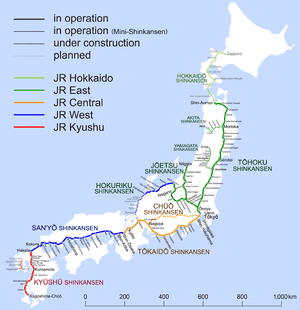
In practice, the Tokaido, Sanyo and Kyushu lines form a contiguous southbound line, as train services run between the Tokaido and Sanyo lines and between the Sanyo and Kyushu lines. The Tokaido Shinkansen is not physically connected to the Tohoku Shinkansen at Tokyo Station. Therefore, there is no through service between those two lines.
Two further lines, known as Mini-shinkansen, have also been constructed by re-gauging and upgrading existing sections of line:
There are two standard-gauge lines not technically classified as Shinkansen lines but with Shinkansen services:
- Hakata Minami Line (Hakata – Hakata-Minami)
- Gala-Yuzawa Line – technically a branch of the Jōetsu Line – (Echigo-Yuzawa – Gala-Yuzawa)
Future lines
Many Shinkansen lines were proposed during the boom of the early 1970s but have yet to be constructed. These are called Seibi Shinkansen (整備新幹線) or planned Shinkansen. One of these lines, the Narita Shinkansen to Narita Airport, was officially cancelled, but a few remain under development.
- Hokuriku Shinkansen extension from Kanazawa to Tsuruga is under construction and is scheduled to open in 2025. Between Hakusan Depot near Kanazawa and Tsuruga, the Fukui Shinkansen station was constructed in conjunction with the rebuilding of the adjoining conventional (narrow gauge) line station in anticipation of construction of the line to Osaka. The extension of the line to Osaka is proposed, with three options for the extension under consideration, being via Maibara, via Kyoto or to the west of Biwako to Shin-Ōsaka.
- Construction of the Kyushu Shinkansen branch from Shin-Tosu to Nagasaki, known as the Nagasaki Route (長崎ルート) or Nishi-Kyushu Route (西九州ルート), started in 2008. The branch will be partially built to full Shinkansen standards (Takeo Onsen - Nagasaki) with the existing narrow-gauge line from Shin-Tosu - Takeo Onsen to remain as narrow-gauge track with Gauge Change Trains to provide the Shinkansen service.
- Hokkaido Shinkansen from Shin-Aomori to Shin-Hakodate is under construction and will open by March 2016. A further extension of the line from Shin-Hakodate to Sapporo is under construction and proposed to open in 2030.
- Chuo Shinkansen (Tokyo–Nagoya–Osaka) is a planned maglev line. The Central Japan Railway Company has announced a 2027 target date for the line from Tokyo to Nagoya, with the extension to Osaka proposed to open in 2045. Construction of the project is due to commence in 2014.
The following lines were also proposed in the 1973 plan, but have subsequently been shelved indefinitely.
- Hokkaido Shinkansen northward extension: Sapporo–Asahikawa
- Hokkaido South Loop Shinkansen (北海道南回り新幹線 Hokkaidō Minami-mawari Shinkansen): Oshamanbe–Muroran–Sapporo
- Uetsu Shinkansen (羽越新幹線): Toyama–Niigata–Aomori
- Ōu Shinkansen (奥羽新幹線): Fukushima–Yamagata–Akita
- Fukushima–Shinjō and Ōmagari–Akita exist as the Yamagata Shinkansen and Akita Shinkansen, respectively, but as "Mini-Shinkansen" upgrades of existing track, they do not meet the requirements of the Basic Plan.
- Hokuriku-Chūkyō Shinkansen (北陸・中京新幹線): Nagoya–Tsuruga
- Sanin Shinkansen (山陰新幹線): Osaka–Tottori–Matsue–Shimonoseki
- Trans-Chūgoku Shinkansen (中国横断新幹線 Chūgoku Ōdan Shinkansen): Okayama–Matsue
- Shikoku Shinkansen (四国新幹線): Osaka–Tokushima–Takamatsu–Matsuyama–Ōita
- Trans-Shikoku Shinkansen (四国横断新幹線 Shikoku Ōdan Shinkansen): Okayama–Kōchi–Matsuyama
- East Kyushu Shinkansen (東九州新幹線 Higashi-Kyushu Shinkansen): Fukuoka–Ōita–Miyazaki–Kagoshima
- Trans-Kyushu Shinkansen (九州横断新幹線 Kyushu Ōdan Shinkansen): Ōita–Kumamoto
In addition, the Basic Plan specified that the Jōetsu Shinkansen should start from Shinjuku, not Tokyo Station, which would have required building an additional 30 km of track between Shinjuku and Ōmiya. While no construction work was ever started, land along the proposed track, including an underground section leading to Shinjuku Station, remains reserved. If capacity on the current Tokyo–Ōmiya section proves insufficient once the Hokkaido and Hokuriku Shinkansen are operational, construction of the Shinjuku–Ōmiya link may be reconsidered.
The Narita Shinkansen project to connect Tokyo to Narita International Airport, initiated in the 1970s but halted in 1983 after landowner protests, has been officially cancelled and removed from the Basic Plan governing Shinkansen construction. Parts of its planned right-of-way were utilized by the Narita Sky Access Line which opened in 2010. Although the Sky Access Line uses standard-gauge track, it was not built to Shinkansen specifications and there are no plans to convert it into a full Shinkansen line.
In December 2009, then transport minister Seiji Maehara proposed a bullet train link to Haneda Airport, using an existing spur that connects the Tōkaidō Shinkansen to a train depot. JR Central called the plan "unrealistic" due to tight train schedules on the existing line, but reports said that Maehara wished to continue discussions on the idea.[35] The current minister has not indicated whether this proposal remains supported.
| Line | Speed | Length | Construction began | Expected start of revenue services | ||
|---|---|---|---|---|---|---|
| km/h | mph | km | mi | |||
| Hokkaido Shinkansen Phase 1 (Shin-Aomori - Shin-Hakodate) | 260 | 160 | 148.9 | 92.5 | May 2005 | April 2016 |
| Kyushu Shinkansen (West Kyushu Route) | 260 | 160 | 66.7 | 41.4 | 2009 | 2022 |
| Hokuriku Shinkansen Phase 3 (Kanazawa - Tsuruga) | 260 | 160 | 120.7 | 75.0 | 2012 | 2023 |
| Hokkaido Shinkansen Phase 2 (Shin-Hakodate - Sapporo) | 260 | 160 | 211.3 | 131.3 | 2012 | 2030 |
List of train models
Trains can be up to sixteen cars long. With each car measuring 25 m (82 ft) in length, the longest trains are 400 m (1/4 mile) end to end. Stations are similarly long to accommodate these trains. Some of Japan's high-speed maglev trains are considered Shinkansen,[36] while other slower maglev trains (such as the Linimo maglev train line serving local community near the city of Nagoya in Aichi, Japan) are intended as alternatives to conventional urban rapid transit systems.

Passenger trains
Tokaido and Sanyo Shinkansen
- 0 series: The first Shinkansen trains, entered service in 1964, and withdrawn in 2008. Maximum operating speed was 220 km/h (135 mph). More than 3,200 cars were built.
- 100 series: Entered service in 1985, and featured bilevel cars with restaurant car and compartments. Maximum operating speed was 230 km/h (145 mph). Later used only on Sanyo Shinkansen Kodama services. Withdrawn in March 2012.
- 300 series: Entered service in 1992, initially on Nozomi services with maximum operating speed of 270 km/h (170 mph). Withdrawn in March 2012.
- 500 series: Introduced on Nozomi services in 1997, with an operating speed of 300 km/h (185 mph). Since 2008, sets have been shortened from 16 to 8 cars for use on Sanyo Shinkansen Kodama services
- 700 series: Introduced in 1999, with maximum operating speed of 285 km/h (175 mph). Now used primarily on Hikari and Kodama services
- N700 series: The most recently introduced type on the Tokaido and Sanyo Shinkansen, in service since 2007, with a maximum operating speed of 300 km/h (185 mph).
Kyushu Shinkansen
- 800 series: In service since 2004 on Tsubame services, with a maximum speed of 260 km/h (160 mph).
- N700-7000/8000 series In service since March 2011 on Mizuho and Sakura services with a maximum speed of 300 km/h (185 mph).
Tohoku, Joetsu, and Hokuriku Shinkansen
- 200 series: The first type introduced on the Tohoku, and Joetsu Shinkansen in 1982 and withdrawn in March 2013. Maximum speed was 240 km/h (150 mph). The final configuration was as 10-car sets. 12-car and 16-car sets also existed in the past.
- E1 series: Bilevel 12-car trains introduced in 1994 and withdrawn in September 2012. Maximum speed was 240 km/h (150 mph).
- E2 series: 8/12-car sets in service since 1997 with a maximum speed of 275 km/h (170 mph).
- E4 series: Bilevel 8-car trains in service since 1997 with a maximum speed of 240 km/h (150 mph).
- E5 series: 10-car sets in service since March 2011 with a maximum speed of 320 km/h (200 mph).
- E7 series/W7 series (delivery under way): 12-car trains ordered for the Hokuriku Shinkansen extension, entered service on the Nagano Shinkansen in March 2014, with a maximum speed of 260 km/h (160 mph).[37]
Yamagata and Akita Shinkansen

- 400 series: The first Mini-shinkansen type, introduced in 1992 on Yamagata Shinkansen Tsubasa services with a maximum speed of 240 km/h. Withdrawn in April 2010.
- E3 series: Introduced in 1997 on Akita Shinkansen Komachi and Yamagata Shinkansen Tsubasa services with a maximum speed of 275 km/h. Now operated solely on the Yamagata Shinkansen.
- E6 series: Introduced in March 2013 on Akita Shinkansen Komachi services, with a maximum speed of 300 km/h (185 mph), raised to 320 km/h (200 mph) in March 2014.
Hokkaido Shinkansen
- H5 series: 10-car sets scheduled to enter service from March 2016 on the Hokkaido Shinkansen with a maximum speed of 320 km/h (200 mph).[38][39]
Taiwan High Speed Rail
- 700T series (Taiwan High Speed Rail, a.k.a. Taiwan Shinkansen): The first Shinkansen type exported outside Japan. 12-car trains based on 700 series entered service in 2007, with a maximum speed of 300 km/h (190 mph).
Experimental trains
- Class 1000 - 1961
- Class 951 - 1969
- Class 961 - 1973
- Class 962 - 1979
- 500-900 series "WIN350" - 1992
- Class 952/953 "STAR21" - 1992
- Class 955 "300X" - 1994
- Gauge Change Train - 1998 to present
- Class E954 "Fastech 360S" - 2004
- Class E955 "Fastech 360Z" - 2005
Maglev trains
- LSM200 – 1972
- ML100 – 1972
- ML100A – 1975
- ML-500 – 1977
- ML-500R – 1979
- MLU001 – 1981
- MLU002 – 1987
- MLU002N – 1993
- MLX01 – 1996
- L0 series – 2012
Maintenance vehicles
- 911 Type diesel locomotive
- 912 Type diesel locomotive
- DD18 Type diesel locomotive
- DD19 Type diesel locomotive
- 941 Type (rescue train)
- 921 Type (track inspection car)
- 922 Type (Doctor Yellow sets T1, T2, T3)
- 923 Type (Doctor Yellow sets T4, T5)
- 925 Type (Doctor Yellow sets S1, S2)
- E926 Type (East i)
List of types of services


Originally intended to carry passenger and freight trains by day and night, the Shinkansen lines carry only passenger trains. The system shuts down between midnight and 06:00 every day for maintenance. The few overnight trains that still run in Japan run on the older narrow gauge network that the Shinkansen parallels.
Tōkaidō Sanyō and Kyushu Shinkansen
- Nozomi (のぞみ) (fast, Tokaido and Sanyo)
- Hikari (ひかり) (semi-fast,Tokaido and Sanyo)
- Hikari Rail Star (ひかりレールスター) (semi fast, Sanyo)
- Kodama (こだま) (local,Tokaido and Sanyo)
- Sakura (さくら) (semi-fast, Sanyo and Kyushu)
- Mizuho (みずほ) (fast, Sanyo and Kyushu)
- Tsubame (つばめ) (local, Kyushu)
Tōhoku, Yamagata and Akita Shinkansen
- Hayabusa (はやぶさ) (fast, Tohoku, using only E5 series trains)
- Hayate (はやて) (fast, Tohoku)
- Yamabiko / Max Yamabiko (やまびこ) (semi-fast, Tohoku)
- Nasuno / Max Nasuno (なすの) (local, Tohoku)
- Aoba (あおば) (discontinued)
- Komachi (こまち) (Akita)
- Tsubasa (つばさ) (Yamagata)
Jōetsu Shinkansen
- Toki / Max Toki (とき)
- Tanigawa / Max Tanigawa (たにがわ)
- Asahi / Max Asahi (あさひ) (discontinued)
Hokuriku Shinkansen
- Asama / Max Asama (あさま)
Speed records
Conventional wheeled
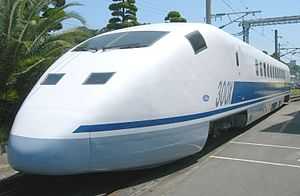
| Speed[40] | Train | Location | Date | Comments | |
|---|---|---|---|---|---|
| km/h | mph | ||||
| 200 | 120 | Class 1000 Shinkansen | Kamonomiya test track in Odawara, now part of Tōkaidō Shinkansen | 31 Oct 1962 | |
| 256 | 159 | Class 1000 Shinkansen | Kamonomiya test track | 30 Mar 1963 | Former world speed record for EMU trains. |
| 286 | 178 | Class 951 Shinkansen | Sanyō Shinkansen | 24 Feb 1972 | Former world speed record for EMU trains. |
| 319.0 | 198.2 | Class 961 Shinkansen | Oyama test track, now part of Tōhoku Shinkansen | 7 Dec 1979 | Former world speed record for EMU trains. |
| 325.7 | 202.4 | 300 series | Tōkaidō Shinkansen | 28 Feb 1991 | |
| 336.0 | 208.8 | 400 series | Jōetsu Shinkansen | 26 Mar 1991 | |
| 345.0 | 214.4 | 400 series | Jōetsu Shinkansen | 19 Sep 1991 | |
| 345.8 | 214.9 | 500-900 series "WIN350" | Sanyō Shinkansen | 6 Aug 1992 | |
| 350.4 | 217.7 | 500-900 series "WIN350" | Sanyō Shinkansen | 8 Aug 1992 | |
| 352.0 | 218.7 | Class 952/953 "STAR21" | Jōetsu Shinkansen | 30 Oct 1992 | |
| 425.0 | 264.1 | Class 952/953 "STAR21" | Jōetsu Shinkansen | 21 Dec 1993 | |
| 426.6 | 265.1 | Class 955 "300X" | Tōkaidō Shinkansen | 11 Jul 1996 | |
| 443.0 | 275.3 | Class 955 "300X" | Tōkaidō Shinkansen | 26 Jul 1996 | |
Maglev trains

| Speed | Train | Location | Date | Comments | |
|---|---|---|---|---|---|
| km/h | mph | ||||
| 550 | 340 | MLX01 | Chūō Shinkansen (Yamanashi test track) | 24 Dec 1997 | Former world speed record |
| 552 | 343 | MLX01 | Chūō Shinkansen (Yamanashi test track) | 14 Apr 1999 | Former world speed record |
| 581 | 361 | MLX01 | Chūō Shinkansen (Yamanashi test track) | 2 Dec 2003 | Former world speed record |
| 590 | 370 | L0 series | Chūō Shinkansen (Yamanashi test track) | 16 Apr 2015[41] | Former world speed record |
| 603 | 375 | L0 series | Chūō Shinkansen (Yamanashi test track) | 21 Apr 2015[4] | World speed record |
Competition with air
Compared with air transport, the Shinkansen has several advantages, including scheduling frequency and flexibility, punctual operation, comfortable seats, and convenient city-center terminals.
The Shinkansen system and airlines often compete with each other for the business of city-to-city domestic travelers. If the Shinkansen connects two cities in less than three hours, most passengers choose the Shinkansen, but if it takes more than four hours by Shinkansen, the majority choose air. Some examples are as follows.
- Tokyo - Nagoya (342 km), Tokyo – Sendai (325 km), Tokyo – Hanamaki (Morioka) (496 km), Tokyo – Niigata (300 km): There were air services between these cities, but they were withdrawn after Shinkansen services started. Shinkansen runs between these cities in about two hours or less.
- Tokyo – Osaka (515 km): Shinkansen is dominant because of fast (2 hours 30 minutes) and frequent service (up to every 10 minutes by Nozomi); however, air travel has a certain share (~20 – 30%).
- Tokyo – Okayama (676 km), Tokyo - Hiroshima (821 km): Shinkansen is reported to have increased its market share from ~40% to ~60% over the last decade.[42] The Shinkansen takes about three to four hours and there are Nozomi trains every 30 minutes, but airlines may provide cheaper fares, attracting price-conscious passengers.
- Tokyo – Fukuoka (1,069 km): The Shinkansen takes about five hours on the fastest Nozomi, and discount carriers have made air travel far cheaper, so most people choose air. Fukuoka (Itatsuke) Airport is near to the CBD - Tenjin, and Fukuoka City Subway Line 1 connects the Airport and Tenjin, via Hakata Station.
- Osaka – Fukuoka (554 km): One of the most competitive sections. The Shinkansen takes about two and a half hours by Nozomi or Mizuho, and the JR West Hikari Rail Star or JR West/JR Kyushu Sakura trains operate twice an hour, taking about 2 hours and 40 minutes between the two cities.
- Tokyo - Aomori (675 km): The fastest Shinkansen service between these cities is 3 hours. JAL is reported to have reduced the size of planes servicing this route since the Shinkansen extension opened in 2010.[42]
Shinkansen technology outside Japan
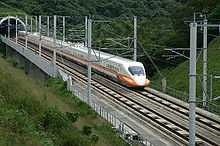
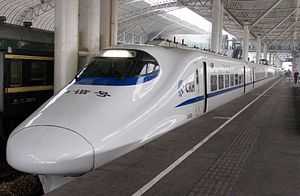
Railways using Shinkansen technology are not limited to those in Japan.
Taiwan
Taiwan High Speed Rail operates 700T Series sets built by Kawasaki Heavy Industries.
China
The China Railways CRH2, built by CSR Sifang Loco & Rolling stocks corporation, with the license purchased from a consortium formed of Kawasaki Heavy Industries, Mitsubishi Electric Corporation, and Hitachi, is based on the E2-1000 series design.
United Kingdom
Class 395 EMUs were built by Hitachi based on Shinkansen technology for use on high-speed commuter services in Britain on the High Speed 1 line.
Brazil
Japan is currently promoting its Shinkansen technology to the Government of Brazil for use on the planned high-speed rail set to link Rio de Janeiro, São Paulo and Campinas.[43] On 14 November 2008, Japanese Prime Minister Tarō Asō and Brazilian President Luiz Inácio Lula da Silva talked about this rail project. President Lula asked a consortium of Japanese companies to participate in the bidding process. Prime Minister Aso concurred on the bilateral cooperation to improve rail infrastructure in Brazil, including the Rio-São Paulo-Campinas high-speed rail line.[44] The Japanese consortium includes the Ministry of Land, Infrastructure, Transport and Tourism, Mitsui & Co., Mitsubishi Heavy Industries, Kawasaki Heavy Industries and Toshiba.[45][46]
United States and Canada
The U.S. Federal Railroad Administration is in talks with a number of countries with high-speed rail, notably Japan, France and Spain. On 16 May 2009, FRA Deputy Chief Karen Rae expressed hope that Japan would offer its technical expertise to Canada and the United States. Transportation Secretary Ray LaHood indicated interest in test riding the Japanese Shinkansen in 2009.[47][48]
On 1 June 2009, JR Central Chairman, Yoshiyuki Kasai, announced plans to export both the N700 Series Shinkansen high-speed train system and the SCMaglev to international export markets, including the United States and Canada.[49]
Vietnam
Vietnam Railways was considering the use of Shinkansen technology for high-speed rail between the capital Hanoi and the southern commercial hub of Ho Chi Minh City, according to the Nihon Keizai Shimbun, citing an interview with Chief Executive Officer Nguyen Huu Bang. The Vietnamese government had already given basic approval for the Shinkansen system, although it still requires financing and formal consent from the prime minister. Vietnam rejected a funding proposal in 2010, so funding for the $56 billion project is uncertain. Hanoi was exploring additional Japanese funding Official Development Assistance as well as funds from the World Bank and Asian Development Bank. The 1,560-kilometre (970 mi) line would replace the current colonial-era rail line. Vietnam hopes to launch high-speed trains by 2020 and plans to start by building three sections, including a 90-kilometre stretch between the central coastal cities of Da Nang and Huế, seen as potentially most profitable. Vietnam Railways had sent engineers to Central Japan Railway Company for technical training.[50][51]
India
India and Japan are conducting feasibility studies on high-speed rail and dedicated freight corridors. The Indian Ministry of Railways' white-paper Vision 2020[52] submitted to Indian Parliament by Railway Minister Mamata Banerjee on 18 December 2009[53] envisages the implementation of regional high-speed rail projects to provide services at 250–350 km/h.
During Indian Prime Minister Manmohan Singh's visit to Tokyo in December 2006, Japan assured cooperation with India in creating a high-speed link between New Delhi and Mumbai.[54] In January 2009, the then Railway Minister Lalu Prasad rode a bullet train travelling from Tokyo to Kyoto.[55]
In December 2013 a Japanese consortium was appointed to undertake a feasibility study of a ~500 km high-speed line between Mumbai and Ahmedabad by July 2015.[56] A total of 7 high-speed lines are in planning stages in India, and Japanese firms have now succeeded in winning contracts to prepare feasibility studies for three of the lines.
See also
References
- ↑ "About the Shinkansen Outline". JR Central. March 2010. Retrieved 2 May 2011.
- ↑ "JR-EAST:Fact Sheet Service Areas and Business Contents" (PDF). East Japan Railway Company. Retrieved 30 April 2011.
- ↑ "Tohoku Shinkansen Speed Increase: Phased speed increase after the extension to Shin-Aomori Station". East Japan Railway Company. 6 November 2007. Retrieved 2 May 2011.
- ↑ 4.0 4.1 4.2 "Japan's maglev train breaks world speed record with 600km/h test run". The Guardian. United Kingdom: Guardian News and Media Limited. 21 April 2015. Retrieved 21 April 2015.
- ↑ "JR Central Japan Website".
- ↑ 6.0 6.1 6.2 "KTX vs 新幹線 徹底比較". Whhh.fc2web.com. Retrieved 10 August 2013.
- ↑ "China High Speed Train Development and Investment". Thechinaperspective.com. 20 November 2012. Retrieved 10 August 2013.
- ↑ Hood, Christopher P. (2007). Shinkansen – From Bullet Train to Symbol of Modern Japan. Routledge, London. pp. 18–43. ISBN 978-0-415-32052-8.
- ↑ 9.0 9.1 9.2 Smith, Roderick A. (2003). "The Japanese Shinkansen". The Journal of Transport History (Imperial College, London) 24/2: 222–236.
- ↑ Fukada, Takahiro, "Shinkansen about more than speed", The Japan Times, 9 December 2008, p. 3.
- ↑ 11.0 11.1 11.2 11.3 11.4 11.5 "Features and Economic and Social Effects of The Shinkansen". Jrtr.net. Retrieved 30 November 2009.
- ↑ "Shinkansen comes to York". Railway Gazette. 1 August 2001. Retrieved 14 September 2014.
- ↑ "Railway Modernization and Shinkansen". Japan Railway & Transport Review. 30 April 2011. Retrieved 30 April 2011.
- ↑ Miura, S., Takai, H., Uchida, M., and Fukada, Y. The Mechanism of Railway Tracks. Japan Railway & Transport Review, 15, 38-45, 1998
- ↑ "Central Japan Railway Company Annual Report 2012" (PDF). p. 16. Retrieved 12 March 2013.
- ↑ "Safety". Central Japan Railway Company. Retrieved 30 April 2011.
- ↑ SHINKANSEN (JAPANESE BULLET TRAINS) AND MAGLEV MAGNETIC TRAINS
- ↑ Report on Niigata Chuetsu Earthquake PDF (43.8 KB)
- ↑ "High-speed bullet train derails in Japan: Media". The Sunday Times. Singapore: Singapore Press Holdings Ltd. Co. 2 March 2013. Retrieved 30 December 2013.
- ↑ 20.0 20.1 "Sensible Politics and Transport Theories?". Jrtr.net. Retrieved 30 November 2009.
- ↑ "新幹線鉄道騒音に係る環境基準について(昭和50年環境庁告示) The Environmental Regulation of Shinkansen Noise Pollution (1975, Environmental Agency) (Japanese)". Env.go.jp. Retrieved 30 November 2009.
- ↑ http://whhh.fc2web.com/ktx/hikaku.html
- ↑ 23.0 23.1 23.2 23.3 23.4 23.5 23.6 http://www.mlit.go.jp/common/000232384.pdf
- ↑ http://www.wantchinatimes.com/news-subclass-cnt.aspx?id=20140628000066&cid=1206
- ↑ http://ktdb.go.kr/web/guest/419
- ↑ http://finance.people.com.cn/stock/n/2015/0130/c67815-26478015.html
- ↑ グループ経営構想Ⅴ [Group Business Vision V] (PDF) (in Japanese). Japan: East Japan Railway Company. 30 October 2012. p. 5. Retrieved 17 November 2012.
- ↑ Construction approved on 3 new bullet train extensions - The Japan Daily Press
- ↑ 29.0 29.1 "Promoting the Tokaido Shinkansen Bypass by the Superconducting Maglev system" (PDF). english.jr-central.co.jp. Retrieved 30 April 2011.
- ↑ "Maglev car design unveiled". The Japan Times. 28 October 2010. Retrieved 28 October 2010.
- ↑ "Most direct line for maglev gets panel OK". The Japan Times. 16 December 2010. Retrieved 16 December 2010.
- ↑ "LDP OKs maglev line selections". The Japan Times. 21 October 2008. Retrieved 21 October 2008.
- ↑ "Economy, prestige at stake in Kyoto-Nara maglev battle". The Japan Times. 3 May 2012. Retrieved 3 May 2012.
- ↑ "鉄道輸送統計調査(平成23年度、国土交通省) Rail Transport Statistics (2011, Ministry of Land, Infrastructure and Transport) (Japanese)". Mlit.go.jp. Retrieved 26 March 2013.
- ↑ "Maehara sounds out JR Tokai over shinkansen link for Haneda airport". Japan Today. 28 December 2009. Retrieved 28 December 2009.
- ↑ "FY2009 Key Measures and Capital Investment - Central Japan Railway Company". Central Japan Railway Company. 27 March 2009. Retrieved 21 June 2009.
- ↑ 北陸新幹線用の新型車両について [New trains for Hokuriku Shinkansen] (PDF). Press release (in Japanese). Japan: JR East & JR West. 4 September 2012. Retrieved 4 September 2012.
- ↑ 北海道新幹線用車両について [Hokkaido Shinkansen Train Details] (PDF). News release (in Japanese). Japan: Hokkaido Railway Company. 16 April 2014. Retrieved 16 April 2014.
- ↑ 北海道新幹線「H5系」、内装には雪の結晶も [Hokkaido Shinkansen "H5 series" - Interiors to feature snowflake design]. Yomiuri Online (in Japanese). Japan: The Yomiuri Shimbun. 16 April 2014. Retrieved 16 April 2014.
- ↑ Semmens, Peter (1997). High Speed in Japan: Shinkansen - The World's Busiest High-speed Railway. Sheffield, UK: Platform 5 Publishing. ISBN 1-872524-88-5.
- ↑ リニア「L0系」、世界最高の590キロ記録 [L0 series maglev sets world speed record of 590 km/h]. Yomiuri Online (in Japanese). Japan: The Yomiuri Shimbunl. 16 April 2015. Retrieved 17 April 2015.
- ↑ 42.0 42.1 "Japanese airlines facing threat from below- Nikkei Asian Review". Asia.nikkei.com. 25 November 2013. Retrieved 7 February 2014.
- ↑ ブラジルに新幹線導入を=日本政府・民間の動き活発化=大統領来日時に働きかけへ=新時代の友好協力の柱に (in Japanese). The Nikkey Shimbun. 31 January 2008. Retrieved 2 June 2009.
- ↑ 日ブラジル首脳会談(概要) (in Japanese). The Ministry of Foreign Affairs of Japan. 14 November 2008. Retrieved 2 June 2009.
- ↑ ブラジルに新幹線進出狙う 三井物産、建設に応札へ (in Japanese). Kyodo News. 12 August 2008. Retrieved 2 June 2009.
- ↑ ブラジルに新幹線売り込み】日本勢、高速鉄道建設で各国と競合 (in Japanese). The Nikkei Net. 17 June 2009. Retrieved 12 July 2009.
- ↑ "U.S. wants to study shinkansen technology". Kyodo News. 16 May 2009. Retrieved 2 June 2009.
- ↑ "U.S. railroad official seeks Japan's help". United Press International. 16 May 2009. Retrieved 2 June 2009.
- ↑ "JR Tokai chief urges U.S. and Canada together to introduce Japan's N700 bullet rail system". JapanToday. 1 July 2009. Retrieved 14 August 2009.
- ↑ ベトナム縦断で新幹線 国営鉄道会長、2020年部分開業目指す (in Japanese). The Nikkei Net. 13 August 2009. Retrieved 13 August 2009.
- ↑ "Vietnam plans Japanese bullet train link". AFP. 13 August 2009. Retrieved 13 August 2009.
- ↑ Indian Railways 2020 Vision - Government of India Ministry of Railways (Railway Board) December, 2009
- ↑ India getting ready for bullet trains - Central Chronicle
- ↑ BBC NEWS | South Asia | India seeks nuclear help in Japan
- ↑ Bullet trains to run in India: Lalu - news.oneindia.in
- ↑ :日本経済新聞 (in Japanese). Nikkei.com. Retrieved 7 February 2014.
External links
| Wikimedia Commons has media related to Shinkansen. |
- Biting the Bullet: What we can learn from the Shinkansen, discussion paper by Christopher Hood in the electronic journal of contemporary Japanese studies, 23 May 2001
- East meets West, a story of how the Shinkansen brought Tokyo and Osaka closer together.
- Bullet on wheels, a travel report by Vinod Jacob 19 August 2005
| |||||||||||||||||||||||||||||||||||||||||||||||||||||||||||||||||||||||||||||
